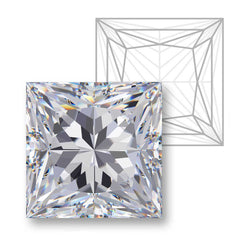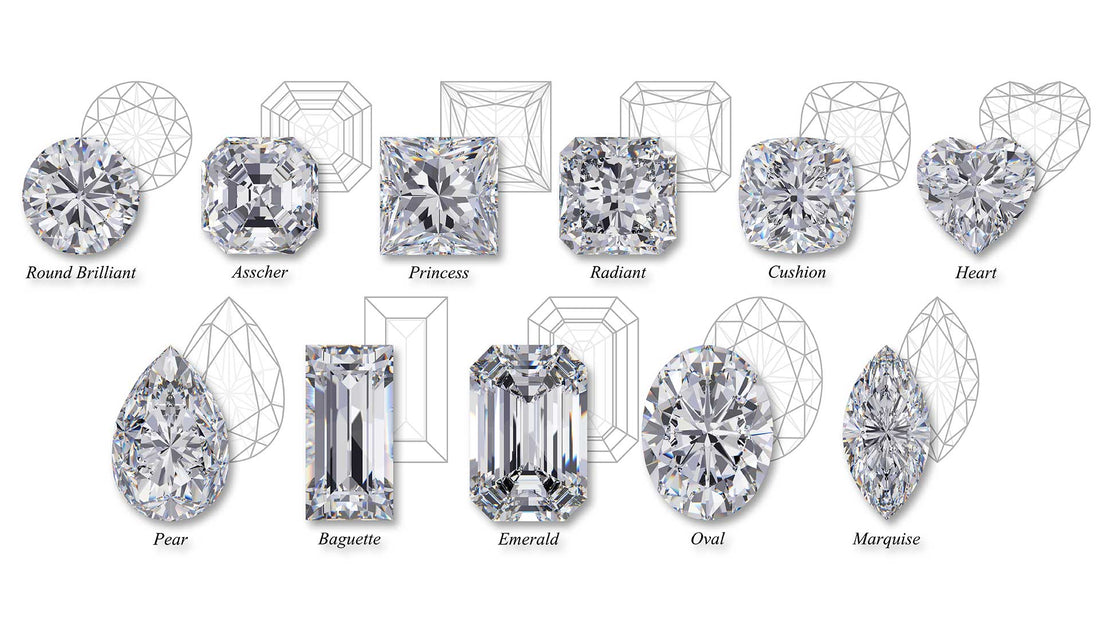What's in the "cut" of a diamond? Is it really a cut? And does the diamond cut actually matter? Let's take a dive into how a diamond is "cut" and what that means for the shape and brilliance.
When jewelers refer to the cut of a diamond what we're really talking about is the physical shape and facets of the diamond. There are two important aspects to the shape of a diamond. First, what it looks like - round, oval, square, heart, etc.; and second, how well that diamond reflects light back out of the diamond.
Reflecting light out of the diamond is an important distinction that we will talk about - light should go into the diamond and reflect back out. It is not intended to reflect off of the surface of the diamond.
But, before getting into all that let's talk about "cutting". People that shape diamonds from rough into the styles that you see are called "Diamond Cutters". There are actually two parts to cutting a diamond. The first step is actually cutting a diamond into a shape that can then be used in the second step, which is polishing it into the facets that create the end product that you see.

As you can see in the picture above, diamonds come in all kinds of shapes and sizes when they are discovered. The most common gem quality rough is an octahedron, which is basically two pyramids on top of each other.
From this rough, the diamond cutter determines where to split it to get the most amount of gem weight and quality possible. In the case of the octahedron rough, the cutter usually cuts the diamond into two separate pyramids, and then uses the two pieces to make two round brilliant cuts.

Diamond cutters today use computer aided modeling to determine how to get the largest and best shape of a diamond out of a piece of rough. As seen above there are two diamonds in that one piece of rough, and when cut correctly this maximizes the amount of diamond that a cutter can get from one piece of rough.
The majority of the work that a diamond cutter performs, however, is not actually cutting, but "polishing" a diamond. That polishing is done on a polishing wheel.

The cutter places diamond dust on the wheel and the wheel spins at a high rate of speed. The diamond is then placed at a precise angle onto the wheel and the diamond dust polishes one "facet" of the diamond. A facet is a flat surface with a specific shape on the surface of the diamond. The cutter then moves to the next facet, and the next, until the diamond is complete.
You can think of the polishing wheel as sandpaper (the diamond dust is the grit). When the cutter places the diamond onto the wheel it smooths out the rough edges into a flat shape. When they are doing this it is creating a facet.
Now that we understand how diamonds get to what they look like in jewelry, let's talk about the end product and what the different shapes and facets do for a diamond.
The Shape of a Diamond
This is what most people think of when they think of the shape of a diamond. Is it round, oval, square? There are all kinds of different shapes when it comes to diamonds. The most popular shape is Round Brilliant. The next most popular shape is Oval, then Princess, then a myriad other fancy shapes. We'll cover the big ones below.

Oval Diamond

The oval diamond keeps gaining in popularity. You only need to look at the Google Search Trends to see. If you or your bride-to-be is trendy you definitely want to check out this shape.
Oval diamonds make beautiful engagement rings, and we love Henri Daussi for this style ring. They have really nice diamonds and a lot of great designs that perfectly suit the shape.
Princess Diamond

The princess cut looks square from the top. Something that we like about the princess cut is that it creates "clean lines" being a square shape, and it also "faces up" a little bigger looking than a round. In contrast to the round, however, it won't produce the same amount of brilliance - more on that in the Round Brilliant Diamond description below.
What can we say besides that, though? It's fit for a Princess!
Cushion Cut Diamond

The cushion cut is a square shape but its corners are rounded off, some can even lean towards the rectangular shape. If you like the square look, but want a little more of the brilliance that you'll find in a round, then the cushion might be a good option for you. For cushions we would also steer you in the direction of our Henri Daussi rings. They have a large selection of gorgeous designs for cushion cuts.
Emerald Cut Diamond

The Emerald Cut Diamond is named that because it's the traditional cut of an emerald and was created to highlight the color, clarity, and vibrance of an emerald gemstone. It works well for diamonds as well because it has long clean lines that creates non-traditional reflections within the diamond.
Marquis Diamond
The Marquis Diamond is an interesting one. It was first created back in the 1700's. King Louis XV had the cut commissioned so that it would resemble the shape of his mistresses lips, which he deemed the most perfect lips of all time. That mistress was the Marquise de Pompadour, Jean Antoinnette Poisson.

Today we tend to also think of the marquis cut as the shape of an eye, and one of our favorite people in the jewelry industry, Ilaria Lanzoni, has started her own jewelry line called "The Look of Love" that features this diamond cut. You can check out the ILANZONI collection here. She has even recently released a marquise diamond engagement ring.
Round Brilliant Diamond

The Round Brilliant is by far the most popular cut of all diamonds, and there's good reason for that. This cut, when done right, will create the most amount of brilliance and intensity of any diamond cut.
The round has the most design possibilities, and you'll find that the rounds are always in stock, whereas some of the other more eclectic fancy shapes have to be special ordered. The round fits great as a solitaire, with a halo, and with all kinds of other options. If you're looking for a Round Brilliant, we have a ton of options of course. We will often show people the Hearts On Fire and Spark lines first. They have some of the best quality diamonds and manufacturing available.
Other Fancy Shapes
There are about as many other shapes of diamonds as you can dream of, beyond even the ones shown in the picture above. Just like King Louis XV, people to this day commission diamond cutters to make their own shapes and create their own patterns. We talked to one diamond cutter when we were in Antwerp and he created a diamond cut that reflected out the Texas Lone Star.
The Facets of a Diamond
There is much more than the simple shape of the diamond when it comes to a good cut. The proportions of the shape will determine the amount of brilliance that a diamond has. Brilliance is how much light is reflected out of the diamond which determines how bright it looks and how much of that "sparkle" you see. This is where you find the difference between an excellent diamond cutter and a mediocre one, or a diamond that sacrifices cut for size.
There is a mathematical formula, invented by Marcel Tolkowsky, that tells the diamond cutter the exact proportions of each facet to reflect 100% of the light out of the top of a round brilliant diamond, illustrated in the photo below.

So, how can you tell if a round diamond has the perfect cut? We have a tool called a "proportion scope" that reflects out light in a way that shows the pattern created by the perfect cut. It's really a very simple tool. It's a 3x magnification scope that lets filtered light in to the diamond which then shows the reflections as shadows.

When the perfect cut is achieved you will see "Hearts and Arrows". That means that from the top you'll see nicely shaped arrows, and when you look at it from the bottom you will see heart shapes. Just for future reference, the top of a diamond is called the "table" and the bottom is called the "pavillion".
Below is a picture of a well cut diamond under the proportion scope with a sample of what it should look like. Notice the Hearts and Arrows?

Below is a diamond that is not cut as well. Can you see the difference?

As you can see, the Hearts and Arrows pattern is what tells us whether or not a diamond has been cut to the proportions in the mathematical formula we talked about previously. So, if you see Hearts and Arrows then the diamond cutter nailed it!
Sometimes a diamond cutter will sacrifice the quality of a cut to get a larger diamond out of the piece of rough that they're using. This does not mean that the diamond is not pretty, it's just a question of what you value. Some people want the size and some want the extra brilliance and intensity provided by the Hearts and Arrows cut.
Hearts On Fire Diamonds
When it comes to the Round Brilliant cut there is nobody that does it better than Hearts On Fire. Using 3D Modeling, anti-vibration technology from Rolls Royce, and visualization technology from NASA, Hearts On Fire has perfected the diamond polishing process. Their trademark is "The World's Most Perfectly Cut Diamond". They have defended that claim three times in a court of law and have won every time.
Closing Thoughts
Our goal at Jewelry Creations has always been to not just sell a product, but to educate people on that product so that they can make the most informed decision posisble and meet the goals they're trying to achieve. I hope that this blog post helped teach you a little something you didn't know about diamonds before.
Be sure to keep an eye out for the next blog post in this series, "Diamond Deep Dive: Clarity", as we continue on our journey exploring the "4 C's" in depth.
Series Links
- Part 1: Diamond Deep Dive: The Cut
- Part 2: Diamond Deep Dive: Clarity
- Part 3: Diamond Deep Dive: Carat Weight
- Part 4: Diamond Deep Dive: Color

